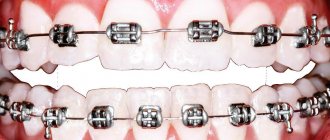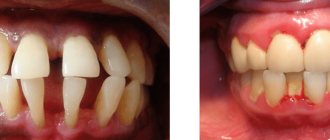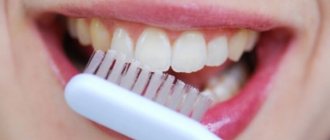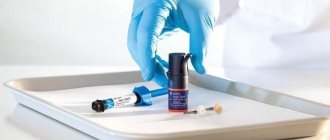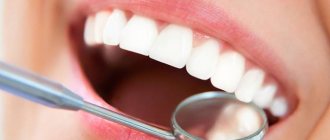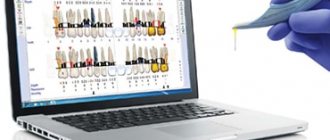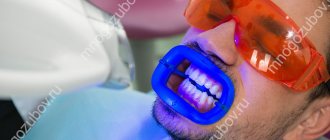The technology of installing artificial roots and then attaching dental crowns to them is becoming more and more popular every year. This is explained by several reasons. Firstly, every year there are more and more clinics in which dentists have mastered this technology. The second reason is the successful development of the technology itself, which has led to fewer and fewer cases of implant failure. Finally, the materials themselves are becoming higher quality, and therefore more durable.
PIC-Optima as a replacement for titanium implants
PIK-Optima is a new biological polymer material from which it is possible to produce implants that are not inferior in their characteristics to titanium analogues. This material was created by French scientists. In 2005, a pilot batch of artificial dental roots was produced from it for the first time. Implants made from PIC-Optima biopolymer have the following advantages:
- very long service life;
- maximum similarity of the material to the bone structure of the jaw;
- the material does not cause an allergic reaction in patients;
- high resistance to chemical influences.
It is also noteworthy that PIK-Optima can be used both to strengthen soft tissues and to strengthen and even replace bone tissue in the oral cavity. Moreover, unlike titanium alloys, this material is very plastic. This allows implants to be manufactured to a given size as accurately as possible, and the flexibility of the material does not provoke bone tissue destruction.
Enamel destruction
Pathology is usually caused by a carious process. Bacteria in the oral cavity disrupt the acid-base balance, which changes the composition of the enamel. The cause of demineralization can be an incorrect diet when there is a deficiency of calcium, phosphorus and fluorine in the body. And also due to chronic diseases associated with inability to absorb calcium and metabolic disorders.
The destruction of the tooth surface can be stopped by a remineralization procedure. But only if the hard tissues of the tooth are not damaged. That is, caries is at the initial stage.
The dental treatment procedure includes:
- Professional cleaning, removing soft and hard plaque.
- Treatment of the surface of teeth with special compounds containing calcium (8-10%).
- Installation of a temporary mouth guard with therapeutic gel (sodium fluoride, calcium hydroxide).
The course of enamel restoration includes 7-10 sessions, depending on the condition of the teeth. The procedure takes no more than half an hour, is absolutely safe and painless.
Zirconium dioxide implants
Implants made from zirconium dioxide successfully replace metal structures. In addition, zirconium implants are implanted into bone tissue much faster than titanium ones. Zirconium dioxide is highly resistant to mechanical loads, both static and dynamic. It is quite easy to process and integrate into the jaw bones.
The advantages of the material include:
- high strength;
- long service life;
- no allergic reaction in patients.
Zirconium dioxide, unlike titanium alloys, does not release metal microparticles into the soft tissues of the oral cavity.
Dental treatment under sedation
Dentists are gradually abandoning full anesthesia for major surgery for adults or restless children. It is being replaced by sedative therapy. What is the difference? Anesthesia is a complete shutdown of the patient’s consciousness with the elimination of pain sensitivity. It is worth saying that such an operation has negative consequences.
Sedation is immersion in a shallow sleep without turning off consciousness using medications that do not cause addiction. Also, these drugs significantly raise the threshold of pain sensitivity, making the process of dental work completely insensitive. Sedative therapy has fewer contraindications and side effects, and the patient recovers much faster. This type of sedation allows for a large volume of dental procedures to be performed at once.
Basal implantation
Basal dental implantation is considered a relatively new technology; it is not mastered in all Russian dental clinics. This method is used both for complete loss of teeth and for the absence of one or more teeth. Basal implantation allows you to install a dental crown on an artificial root without waiting for it to grow tightly into the bone tissue. This method has become truly revolutionary, since the implantation of conventional titanium implants can last more than one month, and all this time the patient experiences discomfort in the oral cavity.
Initially, basal implantation involved the use of lateral implants with a disc base. Unfortunately, they did not perform as expected. Bone tissue often rejected such an implant. In addition, soft tissue injury sometimes occurred during the installation process. Nowadays, such implants are not used at all in dentistry. Instead, dental surgeons use screw implants with deep threads and a large thread pitch at the bottom of the implant. This ensures the initial tight fit of the structure in place. Artificial dental crowns are very conveniently attached to screw implants. Basal implantation is indicated:
- with partial or complete loss of teeth;
- with partial atrophy of the jaw bone;
- if the patient does not want to increase jaw bone tissue;
- If necessary, urgently install an artificial tooth.
Basal implantation is not used in the following cases:
- the patient suffers from diabetes;
- the patient is HIV-infected;
- the patient is sick with tuberculosis;
- the patient has extremely low immunity;
- the patient suffers from nervous or heart diseases;
- the patient has cancer
- The patient has a tone of the masticatory muscles.
Basal implantation is characterized by extremely rare injury to the soft tissues of the oral cavity. At the same time, implantation of the implant into the jaw bone proceeds very quickly. Suffice it to say that within 3-7 days after implantation the chewing function returns to normal. Practice shows that only in ten cases out of a hundred patients require bone tissue augmentation before basal implantation. The cost of basal implantation is half that of classical implantation in two stages.
In our country, dentists prefer to use Swiss Oneway Biomed implants for basal implantation. They are produced by reputable companies Ihde Dental AG and ROOTT. Much less commonly used in Russia are German shortened Triton Titanium implants, as well as Israeli extended zygomatic implants Noris Medical.
Trend No. 4: moving away from sinus lift in the upper jaw
Another trend in recent years, and this year in particular, is a gradual shift away from sinus lifting, i.e. displacement of the nasal sinus for the installation of implants. This is relevant, accordingly, only for the upper jaw and only for those patients who are missing at least 3 teeth in the lateral area. Well, the protocol is also suitable for those who have no teeth left.
So, in addition to the methods listed in the previous paragraph, zygomatic implants are also actively used in the upper jaw today. What are they? They are longer than the classic ones, and are used for one-stage implantation protocols in different quantities (as a rule, two, four or a maximum of 6 pieces per row), in the presence of strong atrophic processes in the lateral zones of the jaw. And they are installed at an angle and bypassing the maxillary sinuses, directly into the deep zygomatic bone, completely unaffected by inflammation and atrophy. This makes it possible to avoid such an operation as a sinus lift and the associated risks of damage to the nasal sinuses, and they stand so tightly and reliably that the risk of them falling out or the slightest loosening is completely eliminated.
Such implants are developed by the company Nobel, already known to you (this company was the first to release the model). They are also in the assortment of the Southern Implants company, and with basal implantation protocols, “assistants” from the Biomed company come to the rescue.
ROOTT implant system
The Rutt system includes more than a hundred different implants. This allows materials from a single manufacturer to carry out any type of artificial root implantation. Rutt System implants can be fixed into the jawbone using dental cement, multi-unit or ball-shaped attachments.
The basal implants of the ROOTT system are structurally a single piece with an adapted abutment. The surface of these implants is perfectly smooth, which virtually eliminates the deposition of bacteria. Moreover, such implants are implanted very quickly due to deep threads. Finally, such artificial roots can be installed immediately after the removal of a damaged tooth. Advantages of Rutt system implants:
- minimum cases of rejection;
- ease of installation;
- no contraindications for patients with HIV, AIDS, hepatitis and diabetes;
- installation is allowed for heavy smokers
- the ability to implant roots in case of periodontal diseases.
Modeling and 3D printing
Computer modeling and manufacturing technologies using 3D printing are beginning to revolutionize dental laboratories. They are being transformed into significantly cheaper and more efficient digital laboratories.
With the help of new technologies, the manufacturing process, for example, of crowns, is significantly accelerated. The tooth is prepared for installation of the prosthesis, then a picture of it is taken, which is sent to the computer, which controls the machine, which produces a crown suitable for this particular patient right in the office and very quickly.
By using 3D printing, all intermediate stages that create a queue are eliminated, and the doctor’s work is significantly simplified. Such solutions for dentists are already offered by Stratasys, Envisiontech and FormLabs.
3D printers are also capable of faster and more accurate creation of orthodontic models, surgical guides, aligners, retainers, and more dental equipment. These are tasks that would take longer using traditional methods. This helps improve workflows, reduce errors and effort, ultimately saving time and money.
The importance of this technology has been further highlighted during the COVID-19 crisis as it can bypass traditional supply chains to meet hospital needs. Since the technology is expected to become an integral part of medical practice, it will also be introduced in dental laboratories.
Implants with tapered abutment connection
Such structures are non-demountable. Their conical abutment ensures uniform load over the entire area of the implant, which dramatically reduces the likelihood of root loosening while chewing solid food. Such implants can be installed below the level of the cortical bone, in the area of which there is very little blood circulation.
The advantages of this technology are:
- monolithic design;
- uniform load distribution over the entire area of the implant;
- impossibility of penetration of pathogenic microorganisms to bone tissues:
- fast and very tight implantation of the implant into bone tissue;
- the technology does not interfere with normal blood circulation in the oral cavity;
- natural appearance;
- long service life.
Latest achievements in Israeli dentistry
Nowadays, Israeli dentists implant artificial roots using their own technology. Its main difference is the long duration of the operation. It usually lasts from 4 to 8 hours.
Painkillers are introduced gradually and using Sleeper One technology. This ensures maximum comfort for the patient. The first effect of anesthesia begins only 40 minutes after the start of the injection. At the same time, by the beginning of the operation itself, the nerve endings in the jawbone area are completely blocked.
Implantation of artificial roots in Israel is done only in inpatient departments of dental clinics. The time for postoperative rehabilitation there lasts at least three days. During this time, the patient should be absolutely at rest and strictly follow the doctor’s recommendations. Postoperative drug treatment is carried out strictly individually and taking into account the characteristics of the patient’s body. In most cases, dentists prescribe anti-inflammatory and antibacterial agents.
What implants do Japanese dentists use?
Japanese scientists under the leadership of Professor Takashi Tsuji managed to develop a biohybrid dental implant. Its structure is not much different from the structure of human bone. Such implants almost never fail. In simple terms, the essence of the invention of Japanese scientists is that the titanium base of the implant is covered on all sides with a layer of a unique material consisting of hydroxyapatite and stem cells of dental follicles. This layer is precisely an analogue of human bone tissue.
Such implants are quickly and most importantly firmly implanted into the jawbone and, what is most surprising, after a while the artificial tooth begins to function like a real one. It is able to sense pain, mechanical impact and the temperature of food or drink.
It should be said that work on creating such a coating continues. Biohybrid implants have not yet been installed en masse, but this will certainly happen. As for a considerable number of experiments on volunteers, they showed excellent results. Biohybrid implants are indicated:
- with partial and complete loss of teeth;
- with severe thinning of the jaw bone;
- if the patient refuses bone tissue augmentation;
- if urgent restoration of the dentition is necessary after the loss of one or more teeth.
A virtual reality
Just like augmented reality technology, virtual reality (VR) can be used for training and advanced training of dentists. Typically, only a couple of students can peer over the surgeon's shoulder as he performs a complex operation, and this significantly complicates the learning process. But a VR camera allows you to broadcast an operation around the world and do it literally “through the eyes of a surgeon” if students use VR glasses. For example, back in 2015, Nobel Biocare organized a broadcast of dental surgery, which was accessible through virtual reality devices.
Virtual reality technology is also useful for patients. An experiment involving 69 patients showed that VR can be used as an effective distraction tool. Patients wore glasses that displayed calming natural scenes and then recalled the treatment more positively. One such VR tool for reducing dental anxiety is the OperaVR system.
New developments by Malaysian scientists
In Malaysia, scientists have also developed their own special implant, which is intended for older people. The essence of their invention is fundamentally reminiscent of the development of their Japanese colleagues. Malaysians also coat the titanium rod and implant abutment, but with a completely different layer. This protective layer consists of ceramics and magnesium silicate. This layer is also very quickly implanted into the bone tissue.
In addition, Malaysian scientists have come up with a new method for making titanium implants. Its essence consists in microwave sintering of the implant after it is coated with titanium powder.
A leading specialist in the development of new dental technologies in Malaysia is scientist Alirez Yaghoubi. He heads an entire scientific group of highly qualified specialists. This group is developing personalized dental systems. In their opinion, this approach is the most promising.
Expected prospects in the field of dental implantation
Modern implants from well-known manufacturers no longer need replacement. The appearance of artificial teeth is practically no different from the appearance of real healthy teeth. However, scientists continue to work to further improve this technology. The ultimate goal in this area of dentistry is to be able to completely imitate the patient's natural dentition.
Spanish scientists have already managed to take the first step in this direction. They created an artificial tooth root, the protective layer of which, during the process of implantation, decomposes and turns into natural bone tissue.
Smart toothbrushes
The “smart” toothbrushes that have appeared on the market, according to their manufacturers, make it much easier to maintain oral hygiene and prevent the formation of plaque or caries.
The Kolibree Electric Toothbrush provides proper teeth cleaning and offers children different games to maintain the habit of brushing regularly. The Philips Sonicare smart toothbrush comes with sensors in the handle. They provide real-time feedback through a companion app, warning you if you're using too much force when brushing your teeth and even coaching the user on how to brush properly. There are several such devices on the market, including from companies such as Colgate and Oral-B.
True, we must admit that these are technologies that are not particularly necessary. While having a personal trainer to optimize your daily oral hygiene routine may seem tempting, not everyone is enthusiastic about the technology. An app like this tells you to change your brushing, but doesn't improve that technique. Rather, this will be done by the dentist, who can demonstrate the correct technique at the next appointment.
Additionally, by purchasing smart toothbrushes from companies like Procter & Gamble and Philips Oral Healthcare, you agree to their privacy policies, which allow them to share your data with third parties. So you might want to consider getting a toothbrush like this only from a company that gives you more control over your data, or one that won't share it with third parties at all.
